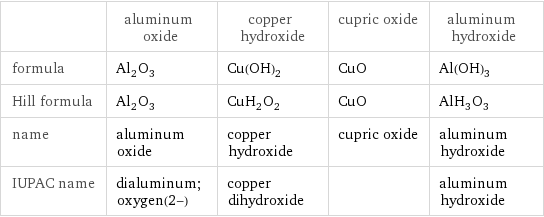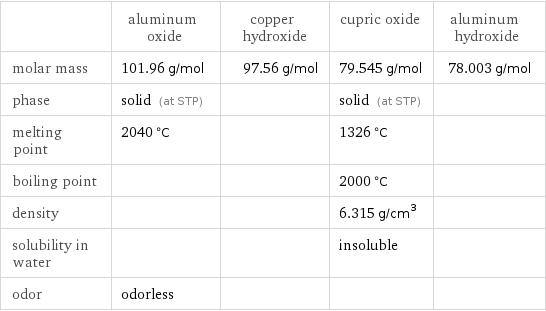Input interpretation

Al_2O_3 aluminum oxide + Cu(OH)_2 copper hydroxide ⟶ CuO cupric oxide + Al(OH)_3 aluminum hydroxide
Balanced equation

Balance the chemical equation algebraically: Al_2O_3 + Cu(OH)_2 ⟶ CuO + Al(OH)_3 Add stoichiometric coefficients, c_i, to the reactants and products: c_1 Al_2O_3 + c_2 Cu(OH)_2 ⟶ c_3 CuO + c_4 Al(OH)_3 Set the number of atoms in the reactants equal to the number of atoms in the products for Al, O, Cu and H: Al: | 2 c_1 = c_4 O: | 3 c_1 + 2 c_2 = c_3 + 3 c_4 Cu: | c_2 = c_3 H: | 2 c_2 = 3 c_4 Since the coefficients are relative quantities and underdetermined, choose a coefficient to set arbitrarily. To keep the coefficients small, the arbitrary value is ordinarily one. For instance, set c_1 = 1 and solve the system of equations for the remaining coefficients: c_1 = 1 c_2 = 3 c_3 = 3 c_4 = 2 Substitute the coefficients into the chemical reaction to obtain the balanced equation: Answer: | | Al_2O_3 + 3 Cu(OH)_2 ⟶ 3 CuO + 2 Al(OH)_3
Structures

+ ⟶ +
Names

aluminum oxide + copper hydroxide ⟶ cupric oxide + aluminum hydroxide
Equilibrium constant
![Construct the equilibrium constant, K, expression for: Al_2O_3 + Cu(OH)_2 ⟶ CuO + Al(OH)_3 Plan: • Balance the chemical equation. • Determine the stoichiometric numbers. • Assemble the activity expression for each chemical species. • Use the activity expressions to build the equilibrium constant expression. Write the balanced chemical equation: Al_2O_3 + 3 Cu(OH)_2 ⟶ 3 CuO + 2 Al(OH)_3 Assign stoichiometric numbers, ν_i, using the stoichiometric coefficients, c_i, from the balanced chemical equation in the following manner: ν_i = -c_i for reactants and ν_i = c_i for products: chemical species | c_i | ν_i Al_2O_3 | 1 | -1 Cu(OH)_2 | 3 | -3 CuO | 3 | 3 Al(OH)_3 | 2 | 2 Assemble the activity expressions accounting for the state of matter and ν_i: chemical species | c_i | ν_i | activity expression Al_2O_3 | 1 | -1 | ([Al2O3])^(-1) Cu(OH)_2 | 3 | -3 | ([Cu(OH)2])^(-3) CuO | 3 | 3 | ([CuO])^3 Al(OH)_3 | 2 | 2 | ([Al(OH)3])^2 The equilibrium constant symbol in the concentration basis is: K_c Mulitply the activity expressions to arrive at the K_c expression: Answer: | | K_c = ([Al2O3])^(-1) ([Cu(OH)2])^(-3) ([CuO])^3 ([Al(OH)3])^2 = (([CuO])^3 ([Al(OH)3])^2)/([Al2O3] ([Cu(OH)2])^3)](../image_source/52c17558b9eb5c5bab7f083e6740a021.png)
Construct the equilibrium constant, K, expression for: Al_2O_3 + Cu(OH)_2 ⟶ CuO + Al(OH)_3 Plan: • Balance the chemical equation. • Determine the stoichiometric numbers. • Assemble the activity expression for each chemical species. • Use the activity expressions to build the equilibrium constant expression. Write the balanced chemical equation: Al_2O_3 + 3 Cu(OH)_2 ⟶ 3 CuO + 2 Al(OH)_3 Assign stoichiometric numbers, ν_i, using the stoichiometric coefficients, c_i, from the balanced chemical equation in the following manner: ν_i = -c_i for reactants and ν_i = c_i for products: chemical species | c_i | ν_i Al_2O_3 | 1 | -1 Cu(OH)_2 | 3 | -3 CuO | 3 | 3 Al(OH)_3 | 2 | 2 Assemble the activity expressions accounting for the state of matter and ν_i: chemical species | c_i | ν_i | activity expression Al_2O_3 | 1 | -1 | ([Al2O3])^(-1) Cu(OH)_2 | 3 | -3 | ([Cu(OH)2])^(-3) CuO | 3 | 3 | ([CuO])^3 Al(OH)_3 | 2 | 2 | ([Al(OH)3])^2 The equilibrium constant symbol in the concentration basis is: K_c Mulitply the activity expressions to arrive at the K_c expression: Answer: | | K_c = ([Al2O3])^(-1) ([Cu(OH)2])^(-3) ([CuO])^3 ([Al(OH)3])^2 = (([CuO])^3 ([Al(OH)3])^2)/([Al2O3] ([Cu(OH)2])^3)
Rate of reaction
![Construct the rate of reaction expression for: Al_2O_3 + Cu(OH)_2 ⟶ CuO + Al(OH)_3 Plan: • Balance the chemical equation. • Determine the stoichiometric numbers. • Assemble the rate term for each chemical species. • Write the rate of reaction expression. Write the balanced chemical equation: Al_2O_3 + 3 Cu(OH)_2 ⟶ 3 CuO + 2 Al(OH)_3 Assign stoichiometric numbers, ν_i, using the stoichiometric coefficients, c_i, from the balanced chemical equation in the following manner: ν_i = -c_i for reactants and ν_i = c_i for products: chemical species | c_i | ν_i Al_2O_3 | 1 | -1 Cu(OH)_2 | 3 | -3 CuO | 3 | 3 Al(OH)_3 | 2 | 2 The rate term for each chemical species, B_i, is 1/ν_i(Δ[B_i])/(Δt) where [B_i] is the amount concentration and t is time: chemical species | c_i | ν_i | rate term Al_2O_3 | 1 | -1 | -(Δ[Al2O3])/(Δt) Cu(OH)_2 | 3 | -3 | -1/3 (Δ[Cu(OH)2])/(Δt) CuO | 3 | 3 | 1/3 (Δ[CuO])/(Δt) Al(OH)_3 | 2 | 2 | 1/2 (Δ[Al(OH)3])/(Δt) (for infinitesimal rate of change, replace Δ with d) Set the rate terms equal to each other to arrive at the rate expression: Answer: | | rate = -(Δ[Al2O3])/(Δt) = -1/3 (Δ[Cu(OH)2])/(Δt) = 1/3 (Δ[CuO])/(Δt) = 1/2 (Δ[Al(OH)3])/(Δt) (assuming constant volume and no accumulation of intermediates or side products)](../image_source/9db0ad21ce80b57f14b67541404dd78e.png)
Construct the rate of reaction expression for: Al_2O_3 + Cu(OH)_2 ⟶ CuO + Al(OH)_3 Plan: • Balance the chemical equation. • Determine the stoichiometric numbers. • Assemble the rate term for each chemical species. • Write the rate of reaction expression. Write the balanced chemical equation: Al_2O_3 + 3 Cu(OH)_2 ⟶ 3 CuO + 2 Al(OH)_3 Assign stoichiometric numbers, ν_i, using the stoichiometric coefficients, c_i, from the balanced chemical equation in the following manner: ν_i = -c_i for reactants and ν_i = c_i for products: chemical species | c_i | ν_i Al_2O_3 | 1 | -1 Cu(OH)_2 | 3 | -3 CuO | 3 | 3 Al(OH)_3 | 2 | 2 The rate term for each chemical species, B_i, is 1/ν_i(Δ[B_i])/(Δt) where [B_i] is the amount concentration and t is time: chemical species | c_i | ν_i | rate term Al_2O_3 | 1 | -1 | -(Δ[Al2O3])/(Δt) Cu(OH)_2 | 3 | -3 | -1/3 (Δ[Cu(OH)2])/(Δt) CuO | 3 | 3 | 1/3 (Δ[CuO])/(Δt) Al(OH)_3 | 2 | 2 | 1/2 (Δ[Al(OH)3])/(Δt) (for infinitesimal rate of change, replace Δ with d) Set the rate terms equal to each other to arrive at the rate expression: Answer: | | rate = -(Δ[Al2O3])/(Δt) = -1/3 (Δ[Cu(OH)2])/(Δt) = 1/3 (Δ[CuO])/(Δt) = 1/2 (Δ[Al(OH)3])/(Δt) (assuming constant volume and no accumulation of intermediates or side products)
Chemical names and formulas

| aluminum oxide | copper hydroxide | cupric oxide | aluminum hydroxide formula | Al_2O_3 | Cu(OH)_2 | CuO | Al(OH)_3 Hill formula | Al_2O_3 | CuH_2O_2 | CuO | AlH_3O_3 name | aluminum oxide | copper hydroxide | cupric oxide | aluminum hydroxide IUPAC name | dialuminum;oxygen(2-) | copper dihydroxide | | aluminum hydroxide
Substance properties

| aluminum oxide | copper hydroxide | cupric oxide | aluminum hydroxide molar mass | 101.96 g/mol | 97.56 g/mol | 79.545 g/mol | 78.003 g/mol phase | solid (at STP) | | solid (at STP) | melting point | 2040 °C | | 1326 °C | boiling point | | | 2000 °C | density | | | 6.315 g/cm^3 | solubility in water | | | insoluble | odor | odorless | | |
Units
